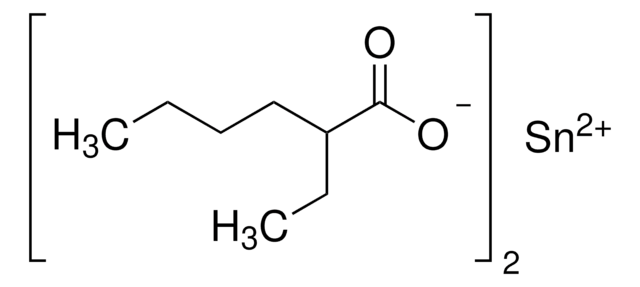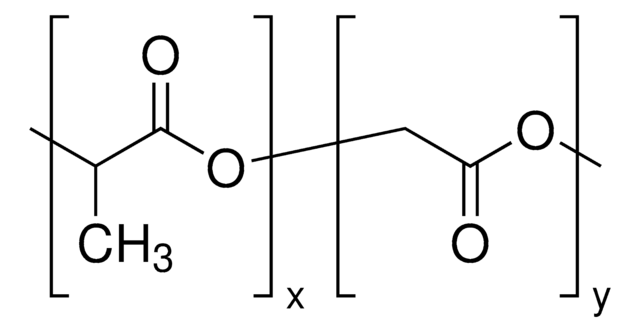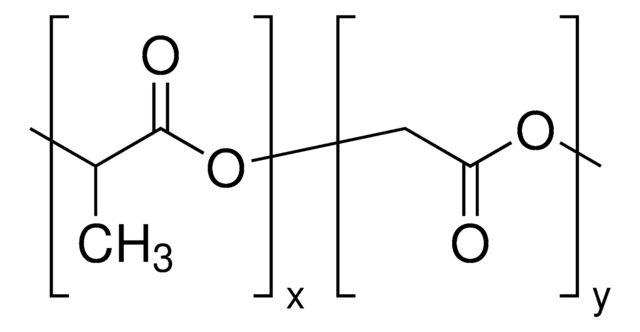922692
Poly(lactide-alt-glycolide)
average Mn 20,000, 50:50 (lactide:glycolide)
Faça loginpara ver os preços organizacionais e de contrato
About This Item
Fórmula linear:
(C5H6O4)n
Código UNSPSC:
12162002
NACRES:
NA.23
Produtos recomendados
Formulário
powder
Nível de qualidade
proporção de alimentação
50:50 (lactide:glycolide)
peso molecular
average Mn 20,000
cor
white to beige
temperatura de armazenamento
2-8°C
Procurando produtos similares? Visita Guia de comparação de produtos
Aplicação
Different from common Poly(lactide-co-glycolide) (PLGA) polymer, the lactic and glycolic units in Poly(lactide-alt-glycolide) alternate in sequence in the polymer chain, and the molar ratio of lactic to glycolic units in the polymer is exactly 1:1. Poly(lactide-alt-glycolide) exhibits excellent solubility in common organic solvents, such as acetonitrile, acetone, dioxane, DCM, and THF, providing great convenience for drug delivery researches and applications.
Common Poly(lactide-co-glycolide) (PLGA) is a biocompatible and biodegradable polymer that has been approved by the FDA for biomedical and pharmaceutical applications. PLGA based polymers are usually synthesized from copolymerization of glycolide (GA) and lactide (LA). However, the copolymerization of glycolide (GA) and Lactide (LA) typically results in broad composition ranges and a random block nature because of the much higher reactivity of GA and the drastic polymerization conditions. Thus, simple use of equimolar charges of GA and LA results in polymers containing longer glycolic blocks leads to poor solubility in common solvents.
Common Poly(lactide-co-glycolide) (PLGA) is a biocompatible and biodegradable polymer that has been approved by the FDA for biomedical and pharmaceutical applications. PLGA based polymers are usually synthesized from copolymerization of glycolide (GA) and lactide (LA). However, the copolymerization of glycolide (GA) and Lactide (LA) typically results in broad composition ranges and a random block nature because of the much higher reactivity of GA and the drastic polymerization conditions. Thus, simple use of equimolar charges of GA and LA results in polymers containing longer glycolic blocks leads to poor solubility in common solvents.
Código de classe de armazenamento
11 - Combustible Solids
Classe de risco de água (WGK)
WGK 3
Ponto de fulgor (°F)
Not applicable
Ponto de fulgor (°C)
Not applicable
Escolha uma das versões mais recentes:
Certificados de análise (COA)
Lot/Batch Number
It looks like we've run into a problem, but you can still download Certificates of Analysis from our Documentos section.
Se precisar de ajuda, entre em contato Atendimento ao cliente
Já possui este produto?
Encontre a documentação dos produtos que você adquiriu recentemente na biblioteca de documentos.
Synthesis of poly(D,L-lactic acid-alt-glycolic acid) from D,L-3-methylglycolide
Dong C M, et al.
Journal of Polymer Science Part A: Polymer Chemistry, 38, 4179-4179 (2000)
Lin Yu et al.
Biomacromolecules, 12(4), 1290-1297 (2011-03-03)
This paper reports the influence of sequence structures of block copolymers composed of poly(lactic acid-co-glycolic acid) (PLGA) and poly(ethylene glycol) (PEG) on their thermogelling aqueous behaviors. A series of thermogelling PLGA-PEG-PLGA triblock copolymers with similar chemical compositions and block lengths
Nossa equipe de cientistas tem experiência em todas as áreas de pesquisa, incluindo Life Sciences, ciência de materiais, síntese química, cromatografia, química analítica e muitas outras.
Entre em contato com a assistência técnica






